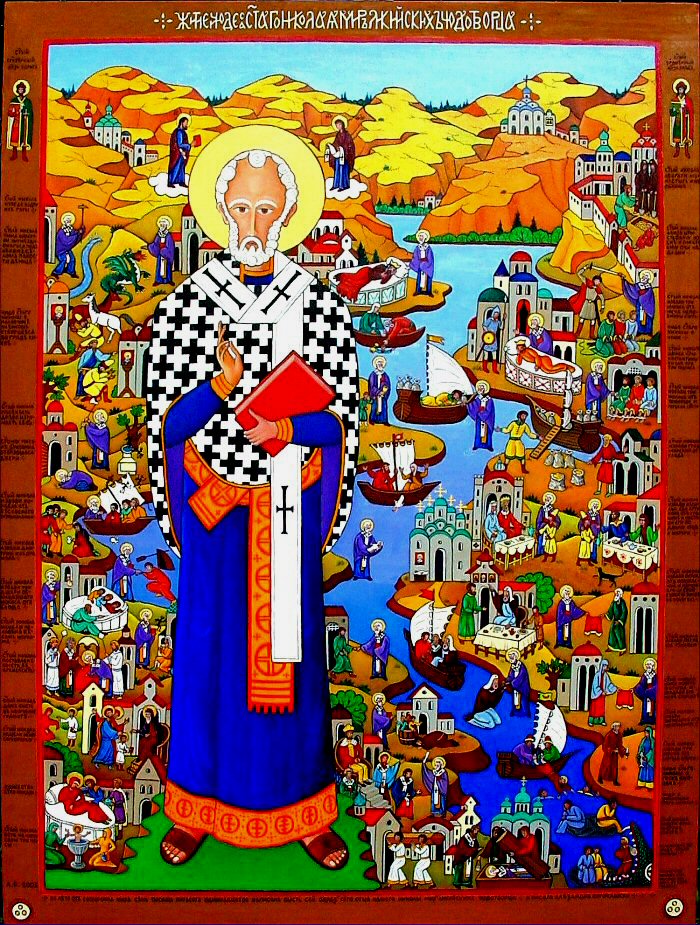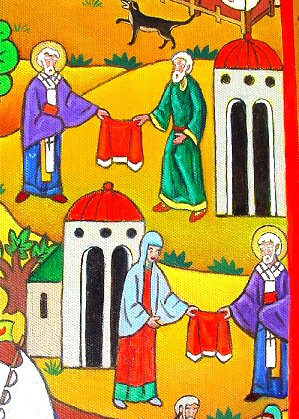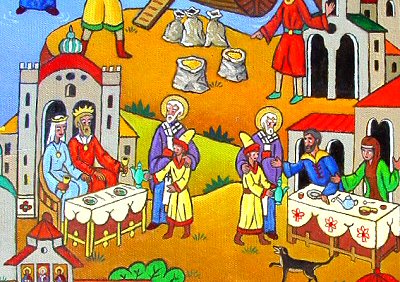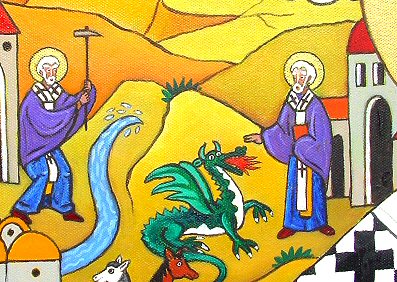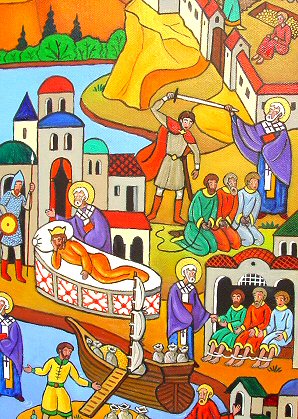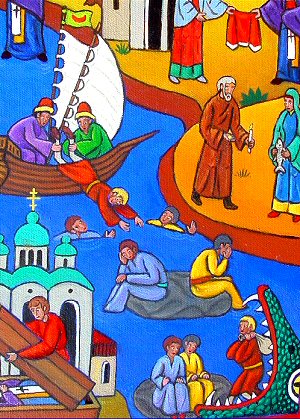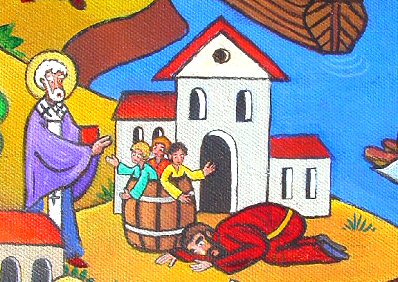ST. NICHOLAS
Oil on canvas, 36 x 48 inches, 2003
(Collection of St. Nicholas Center, Holland, Michigan)
This painting, slightly
different stylistically than the others, was created in connection with the
artist's life-long interest in St. Nicholas of Myra, the topic of the artist's doctoral dissertation. It was supposed to be
a work like a traditional icon, but not entirely so. Iconic elements
include bright colors, flatness of the composition, and the lack of the
traditional perspective. Most of the miracles from the life of the saint
are based on existing real icons, but here they are combined to fill the
background of the painting rather than being distributed around the margins of
the work in small rectangular boxes. Non-iconic details are color
transitions, particularly in the river, the landscape, and the garments of the
saint, as well as a few Western miracles, known only from the Golden Legend.
The stories from the life of the saint are told more or less chronologically:
they begin in the lower left corner with the birth of the saint, his schooling,
and his first miracle of healing a woman with a withered arm. Going upwards, we
see the saint's consecration as a bishop, his healing of a demoniac, and his
saving of the three girls in Constantinople from prostitution. Next, the
saint saves Demetrios from drowning and rescues a ship from the wrath of the
goddess Artemis; later, he arrives in Palestine and the doors of a church
miraculously open for him. He expels devils from a well and a tree, forces a
Polovtsian to bring the promised ransom to his benefactor in Kiev, extracts
water from a mountain, and defeats a dragon. The last miracle is very
rare and can be found only in one Russian version of the saint's vita and in one icon. In the
upper section, next to the head of the saint, we see his miracle of returning
the sight to the Serbian king Stephen and, across the river, his miracle of
enriching a poor monastery. Below the monastery miracle, the saint saves three
innocent men from execution, he appears to the Emperor Constantine in a dream,
and he saves the other innocent three men from prison. Across the river
from these three scenes, under the scene with king Stephen, the saint saves a
boy from drowning and makes his father bring to the saint's church the promised
precious goblet. This story, known only from the Golden Legend, finds a
parallel in Old Russian texts, in which a boy is saved from drowning and
placed, safe and sound, on the altar of St. Sophia cathedral in Kiev. This miracle is
illustrated after the miracles of bringing a ship full of grain to the city of
Myra during a famine and returning Basil, captured by Saracens, to his parents.
Below the latter miracle, the saint buys a carpet from an old man and returns it
to the man's wife, he saves a patriarch from drowning, and he releases Peter of
Athos from prison. Below the miracle with Peter, we see the rendition of another
uniquely Western tale, in which the saint restores to life three students
who were pickled in a barrel by a greedy innkeeper. Below the barrel miracle the
saint appears at the first Ecumenical Council in Nicaea, during which he stands
firm against the heresy of Arius. Across the river, under the carpet miracle, we
see another story not illustrated in icon painting -- a story of a poor man who
gave away all his remaining money to the poor and was richly rewarded by the
saint. This miracle and the miracle at the Council frame the fascinating story
of the three merchants, thrown off a ship by the pagan crew, but saved by the
saint, who sent a stone and a whale to their rescue. The last two scenes
depict the burial of the saint and the translation of his relics from Myra to
Bari in southern Italy. Next to the head of the saint we see Christ and the
Virgin, two images related to the story of the saint's participation in the
Council against Arius: when the saint defended the Church too vigorously,
he was put in prison and his Gospel book and omophorion were taken away from
him. However, Christ and the Virgin appeared to the saint in prison and
returned these objects to him, confirming his bishop's position. The
picture is framed by inscriptions in Old Russian, describing briefly all the
miracles. On the top, the fanciful letters spell The Life and Miracles
of St. Nicholas, the Wonderworker of Myra in Lycia, and at the bottom an Old
Russian inscription informs about the year of the picture's completion and its
author. Two more figures can be seen at the very top of the painting,
above the miracle inscriptions. These are two Russian martyrs, the princes
Boris and Gleb, murdered by their brother and canonized as the first Russian
Orthodox saints.
Return to Index
